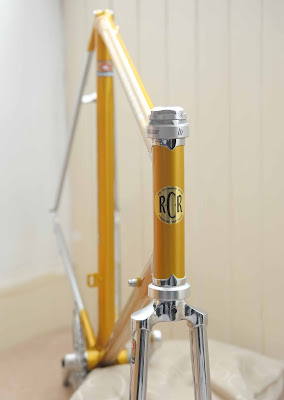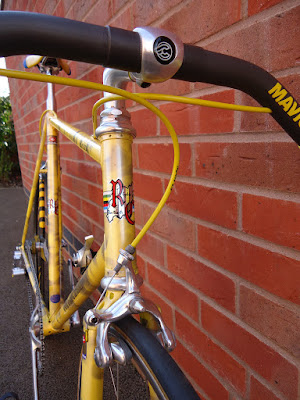UPDATE: Lots of new pics further down.  |
| One of Roy's exhibition frames featured on this page. |
 A search of the web will reveal a raft of websites dedicated to framebuilders long since gone. Many were worthy of these accolades, others less so. But if ever a man deserved some recognition for his work, then it’s Roy Cottingham. Roy’s frames aren’t that well-known outside his native Northants but they exhibit a level of workmanship that stands comparison with the best.
A search of the web will reveal a raft of websites dedicated to framebuilders long since gone. Many were worthy of these accolades, others less so. But if ever a man deserved some recognition for his work, then it’s Roy Cottingham. Roy’s frames aren’t that well-known outside his native Northants but they exhibit a level of workmanship that stands comparison with the best.Roy was born in the 1930s but had he come into the world twenty years earlier there was every chance we’d be talking about him in the same breath as Hetchins or Claud Butler. His undoubted ability to cut and file intricate lug patterns was asked to “flourish” at a time when fashion dictated plainer, simpler legwork.
Although he also made frames in the latter style, Roy’s speciality–his Gothic lugwork–was never going to turn him into a volume producer. Thus it was that he remained very much an artisan whose work was sometimes interrupted by the need to earn a living, giving his framebuilding a somewhat stop-start character.
A trained pharmacist, Roy was also a talented teenage cyclist. A first category racer in the 1950s, he was asked to take part in the Milk Race, then Britain’s premier event, when he was 19. His father didn’t fancy the idea and Roy was never given a second chance. His bike-building began in the early 1960s when he became a partner in a cycling shop in Rushden, Northants with Ian C. Reid. Ian was a trained framebuilder and Roy learned the craft from him. The two produced frames bearing their individual names but the shop business didn’t prove as successful as they had hoped and Roy left in the late 1960s, leaving Ian to run it alone.
Roy was born in the 1930s but had he come into the world twenty years earlier there was every chance we’d be talking about him in the same breath as Hetchins or Claud Butler. His undoubted ability to cut and file intricate lug patterns was asked to “flourish” at a time when fashion dictated plainer, simpler lugwork. Although he also made frames in the latter style, Roy’s speciality–his Gothic lugwork–was never going to turn him into a volume producer. Thus it was that he remained very much an artisan whose work was sometimes interrupted by the need to earn a living, giving his framebuilding a somewhat stop-start character.
A trained pharmacist, Roy was also a talented teenage cyclist. A first category racer in the 1950s, he was asked to take part in the Milk Race, then Britain’s premier event, when he was 19. His father didn’t fancy the idea and Roy was never given a second chance. His bike-building began in the early 1960s when he became a partner in a cycling shop in Rushden, Northants with Ian C. Reid. Ian was a trained framebuilder and Roy learned the craft from him. The two produced frames bearing their individual names but the shop business didn’t prove as successful as they had hoped and Roy left in the late 1960s, leaving Ian to run it alone.
The shop appears not to have remained open too long but Ian still managed to produce many fine frames of his own before it closed. During this period, Roy more or less gave up framebuilding until his interest was rekindled in 1985 when, with ex-racer Peter Duker, he started the League International for age-related cycle racing. Roy picked up where he had left off, building a wide range of frames to order from his home, displaying both his fine lugwork and his outstanding ability with a torch. Initially, his frames were in demand and he was quite prolific but his productivity tailed off until, in the last few years before his death in 1998, only a few were made each year. He gained a measure of fame in cycling circles through his appearances in Cycling Weekly’s annual round-up of framebuilders, a magazine in which he occasionally placed adverts. However, it’s fair to say that very few cyclists outwith Northants will be at all familiar with the name Cottingham in a framebuilding context. Hopefully, this page will go some way towards remedying that.
The shop appears not to have remained open too long but Ian still managed to produce many fine frames of his own before it closed. During this period, Roy more or less gave up framebuilding until his interest was rekindled in 1985 when, with ex-racer Peter Duker, he started the League International for age-related cycle racing. Roy picked up where he had left off, building a wide range of frames to order from his home, displaying both his fine lugwork and his outstanding ability with a torch. Initially, his frames were in demand and he was quite prolific but his productivity tailed off until, in the last few years before his death in 1998, only a few were made each year. He gained a measure of fame in cycling circles through his appearances in Cycling Weekly’s annual round-up of framebuilders, a magazine in which he occasionally placed adverts. However, it’s fair to say that very few cyclists outwith Northants will be at all familiar with the name Cottingham in a framebuilding context. Hopefully, this page will go some way towards remedying that.
THE FRAMES
Roy always seemed to offer a fairly eclectic mix of frames covering both fancy-lugged and Italian-style and, in his later years, lo-profile and mtb. The earliest catalogue I have, believed to date from the mid-1960s, lists 11 distinct models ranging from a standard Club frame to the four-model Connoisseur line-up, the most elaborate of which had hand cut lugs with “windows” in them. The complete range was:
Standard Models
Club: To specification with 531 throughout. Prugnat 55G or Waltho Oscar Egg pattern lugs. Nervex or Benelux ends. Fork crown with sloping top. Lugs lined in contrast. Magistroni head and bracket fittings. Alloy seat pin and bolt. £13 17s 6d.
Tour of Britain: As above with the addition of either Simplex or Benelux gear fork ends. £14 18s 6d.
Omnium Track: As above with round blades, Italian-style fork crown, Track rear ends. £14 10s 6d.
Giro D’Italia: 55G Italian-style lugs. Italian-style fork blades. No brazed fittings unless requested. Any ends. £15 17s 6d.
Deluxe Road Models
Italian Model: Built with Prugnat long line lugs of either the “S” or “I” pattern. Any rear ends. 5/8 inch stays and chainstays without indents. All stay and fork ends are domed and slotted for strength. Filed and polished to perfection before finishing in any colour enamel, lustre or flamboyant. Positively the last word in Italian-style frames. £16 19s 6d.
French Model: As the Italian style but built with the traditional French pattern stays and fork blades. Nervex Professionelle lugsets and fork crown. Simplex gear fork ends for parallelogram or normal gear, or to choice. £16 19s 6d.
Deluxe Track Models
Built in either the Italian or French styles. One piece fork crown and reinforced rear track ends with long slot. £17 9s 6d.
Connoisseur Range
Undoubtedly the finest range of framesets available today. The lugs are cut from selected steel blanks to our artistic scroll designs. A satisfactory balance has been struck between high grade artistic workmanship and the need for full strength in a joint. The lugs are carefully matched to selected tubes before assembly and then filed down to a feather edge before finishing. To any design. With any ends or brazed fittings not listed as extras.
No. 1 model with No. 1 hand cut lugs or Prugnat-type “S” with extensive windows. £19 19s 6d
No. 2 model with No. 2 lugs. £20 7s 6d
No. 3 model with No. 3 lugs without windows. £21 7s 6d.
No. 3 model with windows in head and seat lugs. The No. 2 bracket shell is used on this model and the No.1 on the other hand cut models. £23 7s 6d.
Matching reinforcements to fork blades or rear bridge ends. £1 0s 0d.
Extras
We do not use Campagnolo gear fork ends but use instead the Benelux type end which is complete with adjusters and lug for Campagnolo gear and is virtually indistinguishable from the genuine article. Since it is considerably cheaper, we can offer this end for Campagnolo or Benelux Super 60 gear at no extra cost on all models.
Lever bosses………………………….…….4/- Allen key seat bolt………………….……………10/-
Pressure pump clip……………….…………5/- Reinforced track ends………………….………...10/-
Mafac Criterium fittings………….………..12/6 Plates to brake bridge ends…………….………..10/-
Reinforced fork liners…………….………..10/- Italian-style brake-boss……………….…………10/-
Mafac bridge on seat stays……….....………5/- Genuine Campagnolo ends…………….......…...15/-
Finishing
Flamboyant finish on polished nickel…….85/- Box lining………………………………....…..10/-
Seat tube panel any size, one colour……..7/- Double box lining……………………….....….12/6
Seat tube, three colours…………………12/6 Head tube in contrast…………………………..6/-
Head lugs in contrast……………………12/6 Seat tube, two colours…………………...…….8/6
Rear triangle in contrast…………………10/-
Diamond panel……………………………………..8/6
Diamond panel……………………………………..8/6
Picking out top eyes or fork crown………..5/-
Forks in contrast…………………………………...7/6
Forks in contrast…………………………………...7/6
Feather lining……………………………………….15/-
Plating
Frame and forks………………………….....….140/- Crown………………………………………….7/6
Forks……………………………………….….27/6
Tips, front and rear……………………………..20/-
Tips, front and rear……………………………..20/-
Front and rear ends 6”……………………....…30/-
Rear triangle complete………………………….65/-
Rear triangle complete………………………….65/-
Front and rear ends 11”…………………….....37/6
Seat lugs or wrap-over…………………………20/-
Seat lugs or wrap-over…………………………20/-
¾ forks and rear ends to bridges………......…..42/6
Fancy reinforcements…………………………..20/-
Fancy reinforcements…………………………..20/-
Head lugs………………………………….…..20/-
Split panels to choice per 6” of plating…..…….20/-
Split panels to choice per 6” of plating…..…….20/-
Panel to any tube 6”………………………...…20/-
Chroming of accessories can be undertaken, prices on application. Renovations and repairs are also undertaken. Write for separate list. We do not supply transfers to other finishers and for full satisfaction you should return your frameset to us. Repairs and renovations to the Connosieur models to quotation only.
The pics below have been gathered from around the internet. I can't remember where they came from, now but if the owners contact me I'll add an attribution or remove them altogether if their publication causes any problems.
The pics below have been gathered from around the internet. I can't remember where they came from, now but if the owners contact me I'll add an attribution or remove them altogether if their publication causes any problems.
1985 Chronometro
1990 Columbus Record Low Profile
1990 Columbus SL
1993 SL





























